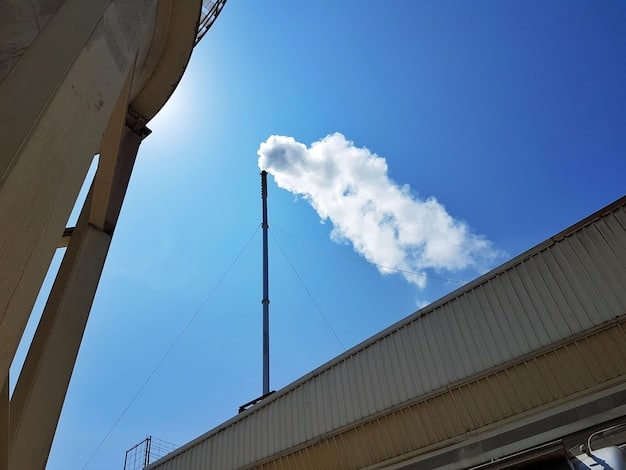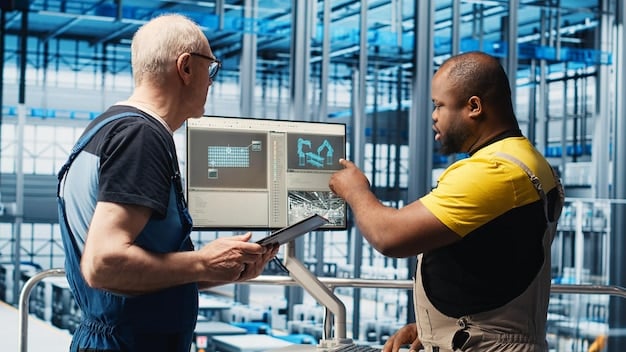EPA’s 2025 Regulations: Air Quality & Industrial Impact Nationwide

Advertisements
The EPA’s new 2025 regulations on industrial emissions aim to significantly improve air quality nationwide by targeting specific pollutants from various industrial sectors, leading to healthier communities and ecosystems.
Advertisements
How Will the EPA’s New 2025 Regulations on Industrial Emissions Impact Air Quality Nationwide? This question is on the minds of many, from environmental advocates to industrial leaders. These forthcoming rules represent a significant stride in environmental policy, poised to reshape America’s industrial landscape and, crucially, the air we breathe.
Understanding the EPA’s Mandate and the 2025 Regulations
The Environmental Protection Agency (EPA) plays a pivotal role in safeguarding public health and the environment in the United States. Its core mission, derived from various environmental statutes, is to ensure clean air, water, and land. This involves setting and enforcing national standards for a wide range of pollutants, conducting research, and providing technical assistance to states and tribes. The new 2025 regulations on industrial emissions are a testament to this ongoing commitment, specifically addressing the persistent challenge of air pollution from industrial sources.
Advertisements
These regulations are not born in a vacuum; they emerge from a complex interplay of scientific data, public health imperatives, and legal mandates. For years, industrial activities have been a major contributor to various air pollutants, including particulate matter, sulfur dioxide, nitrogen oxides, and volatile organic compounds. These substances are known to cause a spectrum of adverse health effects, from respiratory illnesses and cardiovascular problems to premature deaths, particularly in vulnerable populations residing near industrial zones. Furthermore, they contribute to environmental degradation, such as acid rain, haze, and impacts on ecosystems.
Historical Context of Air Quality Regulation
To fully grasp the significance of the 2025 regulations, it’s essential to consider the historical trajectory of air quality efforts in the US. The landmark Clean Air Act, first enacted in 1970 and subsequently amended, laid the groundwork for federal regulation of air pollution. It established National Ambient Air Quality Standards (NAAQS) for critical pollutants and mandated emissions controls for stationary and mobile sources. Over the decades, these regulations have led to substantial improvements in air quality nationwide, but challenges remain, especially concerning specific industrial sectors and emerging pollutants.
- Early Legislation: Initial efforts focused on highly visible pollutants like smog and soot.
- NAAQS Establishment: Defined acceptable limits for key harmful air pollutants.
- Technology-Based Standards: Mandated the use of best available control technologies for various industries.
- Health-Based Approach: Increasingly emphasized public health protection as a primary driver for regulatory action.
The 2025 regulations build upon this foundation, aiming to refine and strengthen existing frameworks to tackle remaining pollution challenges. They are specifically designed to be more targeted, efficient, and impactful, leveraging new scientific understanding and technological advancements in pollution control. The EPA’s approach reflects a continuous evolution, moving towards more comprehensive and effective strategies to protect national air quality.
In summary, these regulations are a critical step forward in the EPA’s ongoing mission. They represent a data-driven response to persistent air quality issues, seeking to mitigate the health and environmental burdens imposed by industrial emissions while fostering innovation in cleaner industrial practices. Understanding their origins and aims is key to appreciating their potential widespread implications across the nation.
Key Provisions and Targeted Pollutants of the 2025 Regulations
The EPA’s 2025 regulations introduce a series of specific provisions aimed at significantly reducing industrial emissions. These provisions are the backbone of the new framework, outlining what industries must do differently and which pollutants are under intense scrutiny. A detailed look at these elements reveals the comprehensive nature of the EPA’s strategy to improve national air quality.
One of the central tenets of the 2025 regulations is the focus on specific industrial sectors that have historically been major contributors to air pollution. This includes, but is not limited to, power generation facilities, chemical manufacturing plants, oil and gas operations, and certain heavy manufacturing industries. The EPA has identified these sectors based on their emissions profiles and their collective impact on ambient air quality and public health.
Targeted Pollutants and Their Health Impacts
The regulations specifically target several key pollutants, each with documented adverse effects on human health and the environment. Understanding these targets is crucial to appreciating the potential benefits of the new rules.
- Fine Particulate Matter (PM2.5): These tiny particles can penetrate deep into the lungs and even enter the bloodstream, contributing to respiratory diseases, heart attacks, and strokes. Industrial processes like combustion, smelting, and manufacturing are significant sources. The new rules mandate tighter controls on dust and aerosol emissions from these sources.
- Nitrogen Oxides (NOx): Primarily released during the combustion of fossil fuels, NOx contributes to the formation of ground-level ozone (smog) and acid rain. It also directly irritates the respiratory system. The regulations will likely require advanced combustion technologies and selective catalytic reduction (SCR) systems in many industrial boilers and furnaces.
- Sulfur Dioxide (SO2): A major precursor to acid rain and fine particulate matter, SO2 is typically emitted from the burning of sulfur-containing fuels, especially coal. Exposure can exacerbate asthma and other respiratory conditions. Flue gas desulfurization (scrubbers) will be increasingly mandated or upgraded under the new rules.
- Volatile Organic Compounds (VOCs): These organic chemicals vaporize easily and contribute to ground-level ozone formation. They can also be toxic on their own, with sources ranging from chemical production to painting operations. The regulations emphasize leak detection and repair programs, as well as the use of lower-VOC materials and enclosed systems.
- Hazardous Air Pollutants (HAPs): Also known as air toxics, these are pollutants known or suspected to cause cancer or other serious health effects. While not always widespread, specific industries emit HAPs in significant quantities. The new regulations will update Maximum Achievable Control Technology (MACT) standards for various HAP sources, pushing for further reductions.
Beyond these primary pollutants, the regulations also address specific industrial processes that contribute to fugitive emissions—those not emitted through a controlled stack, but rather from leaks, evaporation, or other non-point sources. This might include stricter requirements for equipment seals, storage tank designs, and waste handling procedures. The aim is to close loopholes and ensure comprehensive control over all forms of industrial air pollution.
The EPA is also employing a combination of technology-based standards, which dictate the use of specific pollution control equipment, and performance-based standards, which set emission limits but allow industries flexibility in how they achieve those limits. This dual approach aims to promote both proven control methods and innovative solutions. The provisions reflect a nuanced understanding of industrial operations and their environmental footprint, designed to foster compliance while driving continuous improvement in air quality management.

Expected Impacts on Air Quality and Public Health
The implementation of the EPA’s 2025 industrial emissions regulations is anticipated to yield significant positive impacts on both national air quality and public health across the United States. These improvements stem directly from the targeted reduction of key pollutants, leading to a cascade of benefits that will be felt nationwide, but particularly in areas historically burdened by industrial pollution.
One of the most immediate and tangible effects will be a measurable decrease in ambient concentrations of pollutants like PM2.5, NOx, and SO2. Lower levels of these substances in the atmosphere translate directly into cleaner, clearer air. This means less haze, better visibility, and a reduction in the acidic deposition that damages ecosystems and infrastructure. For many communities, this could represent a return to air quality levels not seen in decades, improving daily life and recreational opportunities.
Public Health Benefits
The public health implications of these regulations are profound. Reduced exposure to fine particulate matter and ground-level ozone, for instance, is directly linked to a decrease in respiratory and cardiovascular diseases. This means fewer asthma attacks, lower rates of bronchitis, and a reduction in the incidence of heart disease and strokes. Vulnerable populations, such as children, the elderly, and individuals with pre-existing conditions, stand to benefit enormously, as they are often disproportionately affected by air pollution.
- Reduced Respiratory Illnesses: Fewer cases of asthma, bronchitis, and other lung conditions, especially in children.
- Improved Cardiovascular Health: Lower incidence of heart attacks, strokes, and other heart-related diseases.
- Decreased Premature Mortality: A significant reduction in deaths attributable to long-term exposure to air pollution.
- Enhanced Cognitive Development in Children: Studies suggest cleaner air positively impacts brain development and academic performance.
Furthermore, the targeting of hazardous air pollutants (HAPs) will reduce the risk of cancer and other serious, long-term health effects associated with exposure to these specific toxic chemicals. While HAP emissions are often localized, their impact on nearby communities can be devastating. The new rules aim to mitigate these localized hotspots, bringing much-needed relief to environmental justice communities that have historically borne the brunt of industrial pollution.
Beyond the direct health benefits, there are numerous co-benefits. Healthcare costs are expected to decrease as the burden of air pollution-related illnesses lessens. Productivity may increase due to fewer sick days. There could also be broader societal benefits through improved quality of life and enhanced public well-being as communities experience cleaner environments. The long-term economic advantages of healthier populations often outweigh the immediate costs of regulatory compliance, creating a more sustainable future for all.
The EPA’s projections, based on extensive modeling and scientific data, suggest that these regulations could avert thousands of premature deaths, hundreds of thousands of cases of aggravated asthma, and millions of days of lost work or school annually. These numbers underscore the substantial human benefit that cleaner air provides, making the 2025 regulations a critical investment in the nation’s health.
Challenges and Economic Considerations for Industries
While the EPA’s 2025 regulations promise significant environmental and health benefits, their implementation will undoubtedly present a range of challenges for industrial sectors. Compliance with new, stricter emissions standards often entails substantial economic considerations, including capital investments, operational adjustments, and potential impacts on competitiveness. Striking a balance between environmental protection and economic viability is a perennial challenge in regulatory policy.
One of the primary challenges for industries will be the capital expenditure required to install and upgrade pollution control technologies. For existing facilities, this could mean retrofitting their operations with advanced scrubbers, selective catalytic reduction (SCR) units, or sophisticated leak detection and repair systems. These technologies can be expensive to purchase, install, and maintain, potentially running into millions of dollars for larger facilities. Smaller businesses, with more limited access to capital, may find these costs particularly burdensome.
Operational and Competitive Impacts
Beyond initial investments, industries will also face increased operational costs. Many pollution control systems require dedicated energy consumption, additional raw materials (e.g., reagents for scrubbers), and specialized personnel for maintenance and monitoring. These ongoing expenses can impact a company’s bottom line and potentially affect their pricing strategies, making their products or services less competitive in the market, especially against international competitors operating under less stringent regulations.
- Increased Capital Expenditure: Significant upfront costs for new or upgraded equipment.
- Higher Operating Costs: Ongoing expenses for energy, materials, and skilled labor.
- Potential for Production Delays: Downtime for installation or system reconfigurations.
- Competitive Disadvantage: Higher costs could impact market position relative to less regulated industries or countries.
The regulations may also necessitate changes in industrial processes or even a shift away from certain materials or fuels. For example, industries reliant on high-sulfur coal might need to transition to lower-sulfur alternatives or invest heavily in desulfurization technologies. Such transitions require careful planning, significant investment, and may disrupt established supply chains. The availability of proven and cost-effective control technologies for all types of emissions and industrial processes is another consideration; while many technologies exist, their scalability and efficiency can vary.

Furthermore, the administrative burden of compliance, including detailed record-keeping, reporting, and more frequent monitoring, will add to operational complexities. Industries will need to invest in training personnel and potentially hiring new staff with expertise in environmental compliance and engineering. Delays in obtaining permits or implementing changes could also lead to production losses.
However, it’s also important to note that environmental regulations often spur innovation. Faced with new requirements, industries may develop more efficient production processes, discover new materials, or create novel pollution control technologies that could ultimately reduce costs or open new market opportunities. Some forward-thinking companies already view environmental stewardship not just as a cost but as a driver for long-term sustainability and improved public image. The EPA often provides guidance, technical assistance, and sometimes even financial incentives or flexible compliance pathways to help industries adapt, acknowledging the economic pressures involved.
Technological Advancements in Emission Control
The evolution of environmental regulations has always been closely intertwined with advancements in pollution control technology. The EPA’s 2025 regulations on industrial emissions are no exception; they are both enabled by and will further accelerate the development and deployment of cutting-edge solutions for cleaner industrial operations. As standards become stricter, the demand for more efficient, cost-effective, and versatile control technologies grows, pushing the boundaries of engineering and chemical processes.
One significant area of progress is in the realm of combustion optimization and post-combustion controls. For industries heavily reliant on burning fossil fuels, such as power generation and heavy manufacturing, technologies like advanced low-NOx burners, selective catalytic reduction (SCR), and selective non-catalytic reduction (SNCR) are becoming increasingly sophisticated. SCR systems, for example, use catalysts and ammonia to convert nitrogen oxides into harmless nitrogen and water, achieving very high removal efficiencies.
Emerging Technologies and Smart Systems
Beyond established methods, several emerging technologies hold promise for meeting the 2025 standards and future challenges:
- Carbon Capture, Utilization, and Storage (CCUS): While primarily focused on CO2, CCUS technologies are advancing rapidly. Improved sorbents, membrane separation techniques, and processes that convert captured carbon into valuable products could help industries meet overall emission reduction goals and achieve a broader environmental footprint reduction.
- Advanced Filtration Systems: Enhancements in electrostatic precipitators, fabric filters, and ceramic filters allow for the capture of even finer particulate matter, including PM2.5, with greater efficiency and lower pressure drop, reducing energy consumption.
- Process Intensification: This involves redesigning chemical processes to operate more efficiently, use fewer raw materials, and generate less waste and fewer emissions from the outset. Examples include microreactors and catalytic distillation.
- Smart Environmental Monitoring: The integration of IoT sensors, real-time data analytics, and AI algorithms allows industries to continuously monitor their emissions with unprecedented precision. This not only helps with compliance but also identifies operational inefficiencies that contribute to pollution, enabling proactive adjustments.
- Biofilters and Bioreactors: For industries dealing with volatile organic compounds (VOCs) or odors, biological treatment systems use microorganisms to break down pollutants, offering a sustainable and often lower-cost alternative to traditional chemical or thermal oxidation.
The drive for greater energy efficiency within industrial processes is also a key technological pathway to emission reduction. By simply consuming less energy, industries can reduce the amount of fuel burned and, consequently, the associated emissions. This includes optimizing industrial heating and cooling systems, improving motor and pump efficiency, and recovering waste heat.
Furthermore, the shift towards cleaner energy sources, driven partly by regulatory pressures, will also contribute to lower industrial emissions. As more facilities transition to renewable energy (solar, wind, geothermal) or cleaner fuels (natural gas over coal), the overall emission profile of the industrial sector will transform. The 2025 regulations are poised to accelerate this transition, fostering a market for innovative and cost-effective pollution control solutions that will benefit both industries and the environment. This ongoing cycle of regulation-driven innovation is crucial for achieving long-term air quality goals.
Regional Variations and Environmental Justice Implications
The impact of the EPA’s 2025 industrial emissions regulations will not be uniform across the United States. Due to varying industrial concentrations, regional atmospheric conditions, and socio-economic factors, the benefits and challenges will manifest differently from one region to another. A critical aspect of analyzing these regulations is to consider their implications for environmental justice, ensuring that the benefits of cleaner air are distributed equitably.
Regions with a high density of heavy industry, such as parts of the Midwest, certain Gulf Coast states with petrochemical complexes, and areas with historical industrial legacies, are likely to experience the most significant improvements in air quality. These “industrial corridors” have often borne a disproportionate share of air pollution burdens. Reductions in emissions from power plants, refineries, and chemical manufacturers in these areas could lead to dramatic and noticeable improvements in local air quality, directly benefiting the communities nearby.
Impact on Environmental Justice Communities
Environmental justice communities, defined as minority, low-income, or Indigenous populations that have historically suffered from greater environmental hazards, are often located adjacent to industrial facilities. These communities frequently experience higher rates of asthma, cancer, and other chronic diseases linked to air pollution. The 2025 regulations hold particular promise for these populations.
- Reduced Health Disparities: Tighter controls on pollutants will directly decrease exposure for communities most at risk.
- Improved Quality of Life: Cleaner air can lead to better overall health, reduced medical expenses, and enhanced well-being.
- Community Empowerment: The regulatory process often involves public engagement, providing avenues for affected communities to advocate for stronger protections and accountability.
- Addressing Cumulative Impacts: While not solely focused on cumulative impacts, reducing emissions from multiple sources in a concentrated area lessens the overall burden on fenceline communities.
However, the implementation also presents potential challenges for these communities. While the goal is cleaner air, some industrial facilities might consider relocating or reducing operations if compliance costs are too high, which could result in job losses. It is crucial for regulatory agencies and local governments to work with affected communities to mitigate such economic disruptions and ensure a just transition towards a cleaner economy.
Geographical factors, such as prevailing wind patterns and topography, also play a role. Emissions from a facility in one state might impact air quality in a downwind state, making interstate cooperation and consistent enforcement critical. The EPA’s national scope is essential here, as it can address cross-boundary pollution more effectively than individual state regulations.
In summary, while the 2025 regulations are nationwide, their effects will be felt with varying intensity. The hope is that they will serve as a powerful tool to advance environmental justice, bringing cleaner air and healthier futures to the populations that need it most, thereby evening the playing field in the fight against industrial pollution. Thoughtful implementation and continued monitoring will be key to realizing these equitable outcomes.
Future Outlook and Long-Term Implications
The EPA’s 2025 regulations on industrial emissions represent more than just a set of new rules; they are a pivotal step in an ongoing, evolving effort to manage and mitigate air pollution. Looking beyond the immediate implementation, it’s crucial to consider the future outlook and the long-term implications these regulations will have on the environment, the economy, and society at large. They are likely to set precedents and reshape the trajectory of industrial development and environmental policy for decades to come.
One of the most significant long-term implications is the continued push towards a cleaner, more sustainable industrial economy. As industries adapt to stricter emissions standards, they are likely to invest more heavily in green technologies, renewable energy sources, and circular economy principles. This could foster a new era of industrial innovation where environmental performance is not just a regulatory burden but a driver of competitive advantage and new business models. Companies that proactively embrace these changes are more likely to thrive in the long run.
Evolving Regulatory Landscape and Climate Change Integration
The 2025 regulations may also serve as a blueprint for future environmental policies. As scientific understanding of air pollution and its connections to climate change continues to grow, future regulations are likely to adopt an even more integrated approach. For instance, many of the technologies that reduce conventional air pollutants also inherently reduce greenhouse gas emissions, creating valuable co-benefits. This synergy could lead to future policies that simultaneously address air quality and climate goals, streamlining compliance and maximizing environmental impact.
- Continued Innovation: Ongoing development of cleaner industrial processes and technologies beyond 2025.
- Policy Integration: Future regulations may increasingly merge air quality and climate change objectives.
- Shifts in Industrial Practices: Long-term move towards resource efficiency, waste reduction, and less carbon-intensive production.
- Public Engagement and Transparency: Increased public demand for clean air and greater transparency from industries regarding emissions data.
Furthermore, the improved health outcomes and reduced environmental damage are expected to yield substantial long-term economic benefits. Lower healthcare costs, increased agricultural productivity due to healthier ecosystems, and enhanced aesthetic and recreational value of natural spaces all contribute to a stronger economy. These long-term benefits often far outweigh the upfront costs of regulatory compliance, showcasing the economic wisdom of environmental protection.
The regulations will also reinforce the importance of accurate data collection and transparent reporting. Enhanced monitoring requirements will provide a clearer picture of emission sources and their actual impact, fostering greater public trust and accountability. This continuous feedback loop of data-driven policy refinement will be critical for achieving and maintaining ambitious air quality targets.
In essence, the 2025 regulations are a significant milestone that points towards a future where industrial growth and environmental stewardship are not mutually exclusive but rather interdependent. They underscore a national commitment to public health and a sustainable environment, with ripple effects that will shape the fabric of the nation for generations to come. The goal is a future where clean air is not a luxury, but a fundamental right for all.
| Key Point | Brief Description |
|---|---|
| 🌬️ Cleaner Air | Regulations target PM2.5, NOx, SO2, and VOCs for significant reduction, leading to clearer skies and better visibility. |
| 🏥 Health Benefits | Expected decrease in respiratory and cardiovascular diseases, especially benefiting vulnerable populations. |
| 💰 Industry Challenges | Industries face capital investments, increased operational costs, and potential for competitive impacts due to compliance. |
| 🚀 Tech Advancements | Regulations drive innovation in pollution control, including advanced filtration, combustion optimization, and smart monitoring. |
Frequently Asked Questions About EPA’s 2025 Regulations
▼
The primary goals of the EPA’s 2025 regulations are to significantly reduce industrial air pollution nationwide, improve public health outcomes by lowering exposure to hazardous pollutants, and promote sustainable industrial practices. They aim to safeguard both human well-being and ecosystems from the adverse effects of emissions.
▼
Sectors most affected include power generation, chemical manufacturing, oil and gas operations, and heavy manufacturing. These industries are significant contributors to the targeted pollutants, and will likely need to invest in new technologies and operational changes to meet the stricter standards outlined in the regulations.
▼
By reducing fine particulate matter (PM2.5), nitrogen oxides (NOx), and sulfur dioxide (SO2), the regulations expect to decrease respiratory illnesses like asthma, improve cardiovascular health, and reduce premature deaths. They also aim to lessen cancer risks by controlling hazardous air pollutants, especially in communities near industrial sites.
▼
Industries may face significant economic challenges, including substantial capital investments for new pollution control equipment, increased operational costs for maintenance and energy, and potential impacts on competitiveness. They will also need to manage administrative burdens related to reporting and compliance, which can be costly.
▼
Yes, the regulations are expected to drive extensive innovation in emission control technologies. This includes advancements in carbon capture, utilization, and storage (CCUS), highly efficient filtration systems, process intensification, and smart environmental monitoring using AI and IoT. These technologies offer more effective and sometimes more sustainable compliance pathways.
Conclusion
The EPA’s new 2025 regulations on industrial emissions represent a critical juncture in the ongoing effort to ensure cleaner air for all Americans. By meticulously targeting key pollutants and high-impact industrial sectors, these rules are poised to deliver substantial improvements in air quality, fostering better public health outcomes and mitigating environmental degradation. While industries will face the challenge of adapting to stricter compliance requirements, the push for innovation in pollution control technologies promises to usher in a more sustainable future. Ultimately, these regulations underscore a profound commitment to environmental stewardship and the well-being of communities nationwide, paving the way for a healthier and more resilient nation.





